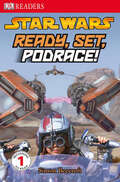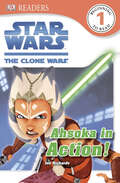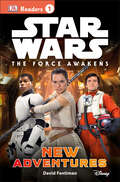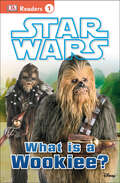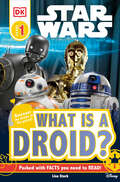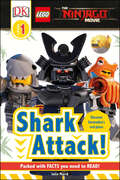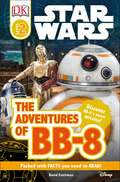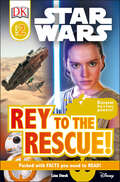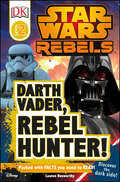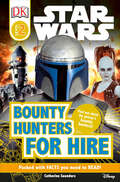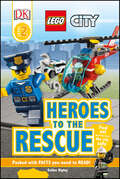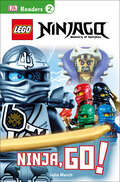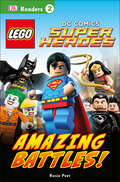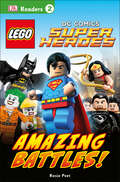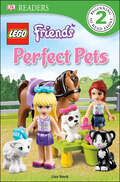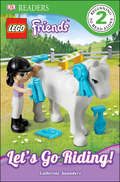- Table View
- List View
DK Readers L1: Star Wars: Ready, Set, Podrace! (DK Readers Level 1)
by Simon BeecroftDK's Star Wars Readers help kids learn to read while enjoying the stories and characters from the blockbuster movies. In Ready, Set, Podrace!, kids can put themselves in the pilot's seat of the fastest race in space! Packed with full-color photographs and engaging, age-appropriate stories, the ebooks introduce young children to a life-long love of reading. These amazing stories are guaranteed to capture children's interest while developing their reading skills. They're also perfect for reading together!© 2012 Lucasfilm Ltd.
DK Readers L1: Star Wars: The Clone Wars: Ahsoka in Action! (DK Readers Level 1)
by Jon RichardsFilled with amazing action shots and pictures from Star Wars: The Clone Wars, this all-new DK Reader is an out-of-this-world read. Learn all about Jedi Padawan Ahsoka Tano and her action-packed adventures with the other characters from the Clone Wars universe. Written with the youngest readers in mind, this Pre-Level 1 reader features simple text, picture word strips, a picture glossary, and labels to introduce and reinforce vocabulary.
DK Readers L1: Star Wars: The Force Awakens: New Adventures (DK Readers Level 1)
by David FentimanIntroduce new readers to the amazing Star Wars™ universe with Star Wars: The Force Awakens™: New Adventures. Part of DK's long established reading program, this reader is a Level 1, designed for those beginning to read. Combining clear, simple text with eye-catching images from The Force Awakens™, this book will help young readers learn to love reading.
DK Readers L1: Star Wars: The Force Awakens: New Adventures (DK Readers Level 1)
by David FentimanIntroduce new readers to the amazing Star Wars™ universe with Star Wars: The Force Awakens™: New Adventures. Part of DK's long established reading program, this reader is a Level 1, designed for those beginning to read. Combining clear, simple text with eye-catching images from The Force Awakens™, this book will help young readers learn to love reading.
DK Readers L1: Star Wars: What Is A Wookiee? (DK Readers Level 1)
by Laura BullerNarrated by everyone's favorite golden droid, C3P0, DK Reader: What Is A Wookie? introduces young readers to some of the strange aliens he has met in his travels, including R2-D2, Yoda, Jar Jar Binks, the ewoks, and, of course, Chewbacca the Wookiee! Reformatted to included additional genre spreads throughout, What is a Wookie? is the perfect introduction to the Star Wars universe for you padawans learning to read.
DK Readers L1: Star Wars™: What is a Droid? (DK Readers Level 1)
by Lisa StockGet to know the most beloved droids in the Star Wars galaxy.Featuring high-quality images from the smash-hit movies and TV series, this Level 1 Reader takes a close look at the coolest droids in the Star Wars galaxy, from new favorites BB-8 (Star Wars: The Force Awakens), K-2SO (Star Wars: Rogue One), and Chopper (Star Wars: Rebels) to treasured old friends from the classic saga C-3PO and R2-D2. Perfect for 3- to 5-year-olds learning to read, Level 1 titles contain short, simple sentences with an emphasis on frequently used words. Stunning photographic images with labels provide visual clues to introduce and reinforce vocabulary.
DK Readers L1: Star Wars™: What is a Droid? (DK Readers Level 1)
by Lisa StockGet to know the most beloved droids in the Star Wars galaxy.Featuring high-quality images from the smash-hit movies and TV series, this Level 1 Reader takes a close look at the coolest droids in the Star Wars galaxy, from new favorites BB-8 (Star Wars: The Force Awakens), K-2SO (Star Wars: Rogue One), and Chopper (Star Wars: Rebels) to treasured old friends from the classic saga C-3PO and R2-D2. Perfect for 3- to 5-year-olds learning to read, Level 1 titles contain short, simple sentences with an emphasis on frequently used words. Stunning photographic images with labels provide visual clues to introduce and reinforce vocabulary.
DK Readers L1: The LEGO® NINJAGO® MOVIE™: Shark Attack! (DK Readers Level 1)
by DKPrepare for Battle with Garmadon's Shark Army!Meet Lord Garmadon. He is the baddest villain in Ninjago City. Learn about his Shark Army and their wicked weapons and discover Garmadon's evil plans. Can the ninja defeat them?Perfect for 3-5 year olds learning to read, Level 1 titles contain short, simple sentences with an emphasis on frequently used words. Crisp photographic images with labels provide visual clues to introduce and reinforce vocabulary.THE LEGO NINJAGO MOVIE © & ™ Warner Bros. Entertainment Inc. & The LEGO Group. LEGO, the LEGO logo, the Minifigure, the Brick and Knob configurations and NINJAGO are trademarks and/or copyrights of the LEGO Group. ©2017 The LEGO Group. All rights reserved. (s17)
DK Readers L1: The LEGO® NINJAGO® MOVIE™: Shark Attack! (DK Readers Level 1)
by DKPrepare for Battle with Garmadon's Shark Army!Meet Lord Garmadon. He is the baddest villain in Ninjago City. Learn about his Shark Army and their wicked weapons and discover Garmadon's evil plans. Can the ninja defeat them?Perfect for 3-5 year olds learning to read, Level 1 titles contain short, simple sentences with an emphasis on frequently used words. Crisp photographic images with labels provide visual clues to introduce and reinforce vocabulary.THE LEGO NINJAGO MOVIE © & ™ Warner Bros. Entertainment Inc. & The LEGO Group. LEGO, the LEGO logo, the Minifigure, the Brick and Knob configurations and NINJAGO are trademarks and/or copyrights of the LEGO Group. ©2017 The LEGO Group. All rights reserved. (s17)
DK Readers L2: Discover BB-8's Secret Mission (DK Readers Level 2)
by David FentimanThe fate of the galaxy depends on BB-8 in DK Readers L2: Star Wars™: The Adventures of BB-8!Follow brave BB-8 as he gets caught up in the battle to save the galaxy. Learn about the heroic Resistance and the sinister First Order. Meet BB-8's new friends, and see them join together to defeat evil!Perfect for 5–7 year olds beginning to read fluently with support, Level 2 titles contain carefully selected photographic images to complement the text, providing strong visual clues to build vocabulary and confidence. Additional information spreads are full of extra fun facts, developing the topics through a range of nonfiction presentation styles such as diagrams, and activities.Fountas and Pinnell Text Level Gradient: RTrusted by parents, teachers, and librarians, and loved by kids, DK's leveled reading series is now revised and updated. With shiny new jackets and brand new nonfiction narrative content on the topics kids love, each book is written and reviewed by literacy experts, and contains a glossary and index making them the perfect choice for helping develop strong reading habits for kids ages 3–11.© & TM 2016 LUCASFILM LTD. Used Under Authorization.
DK Readers L2: Discover Rey’s Force Powers! (DK Readers Level 2)
by Lisa StockMeet Rey, the brave young heroine from the latest installment of the Star Wars™ saga: The Force Awakens™, in DK Readers L2: Star Wars: Rey to the Rescue! Takes a close look at Rey's home planet of Jakku, her fighting and piloting skills, her friends Finn and BB-8, and her evil enemy Kylo Ren in this new reader from DK.Perfect for 5–7 year olds beginning to read fluently with support, Level 2 titles contain carefully selected photographic images to complement the text, providing strong visual clues to build vocabulary and confidence. Additional information spreads are full of extra fun facts, developing the topics through a range of nonfiction presentation styles such as diagrams and activities.© & TM 2016 LUCASFILM LTD. Used Under Authorization.
DK Readers L2: Discover Rey’s Force Powers! (DK Readers Level 2)
by Lisa StockMeet Rey, the brave young heroine from the latest installment of the Star Wars™ saga: The Force Awakens™, in DK Readers L2: Star Wars: Rey to the Rescue! Takes a close look at Rey's home planet of Jakku, her fighting and piloting skills, her friends Finn and BB-8, and her evil enemy Kylo Ren in this new reader from DK.Perfect for 5–7 year olds beginning to read fluently with support, Level 2 titles contain carefully selected photographic images to complement the text, providing strong visual clues to build vocabulary and confidence. Additional information spreads are full of extra fun facts, developing the topics through a range of nonfiction presentation styles such as diagrams and activities.© & TM 2016 LUCASFILM LTD. Used Under Authorization.
DK Readers L2: Discover the Dark Side! (DK Readers Level 2)
by Lauren NesworthyPrepare to meet the rebels' greatest enemy yet!Learn all about one of the most terrifying figures in the Empire, Darth Vader, in DK Reader Level 2: Star Wars Rebels™: Darth Vader, Rebel Hunter! Discover how the evil Sith Lord plans to defeat the rebels once and for all.Perfect for 5–7 year olds beginning to read fluently with support, Level 2 titles contain carefully selected photographic images to complement the text, providing strong visual clues to build vocabulary and confidence. Additional information spreads are full of extra fun facts, developing the topics through a range of nonfiction presentation styles such as diagrams, and activities.Fountas and Pinnell Text Level Gradient: RTrusted by parents, teachers, and librarians, and loved by kids, DK's leveled reading series is now revised and updated. With shiny new jackets and brand new nonfiction narrative content on the topics kids love, each book is written and reviewed by literacy experts, and contains a glossary and index making them the perfect choice for helping develop strong reading habits for kids ages 3–11.© & TM 2016 LUCASFILM LTD. Used Under Authorization.
DK Readers L2: Discover the Dark Side! (DK Readers Level 2)
by Lauren NesworthyPrepare to meet the rebels' greatest enemy yet!Learn all about one of the most terrifying figures in the Empire, Darth Vader, in DK Reader Level 2: Star Wars Rebels™: Darth Vader, Rebel Hunter! Discover how the evil Sith Lord plans to defeat the rebels once and for all.Perfect for 5–7 year olds beginning to read fluently with support, Level 2 titles contain carefully selected photographic images to complement the text, providing strong visual clues to build vocabulary and confidence. Additional information spreads are full of extra fun facts, developing the topics through a range of nonfiction presentation styles such as diagrams, and activities.Fountas and Pinnell Text Level Gradient: RTrusted by parents, teachers, and librarians, and loved by kids, DK's leveled reading series is now revised and updated. With shiny new jackets and brand new nonfiction narrative content on the topics kids love, each book is written and reviewed by literacy experts, and contains a glossary and index making them the perfect choice for helping develop strong reading habits for kids ages 3–11.© & TM 2016 LUCASFILM LTD. Used Under Authorization.
DK Readers L2: Find Out About the Galaxy's Bounty Hunters! (DK Readers Level 2)
by DKWho are the mysterious and dangerous bounty hunters? Meet Boba Fett and his fellow bounty hunters and learn all of their scary secrets in this new Level 2 Star Wars Reader from DK!
DK Readers L2: Find Out About the Galaxy's Bounty Hunters! (DK Readers Level 2)
by DKWho are the mysterious and dangerous bounty hunters? Meet Boba Fett and his fellow bounty hunters and learn all of their scary secrets in this new Level 2 Star Wars Reader from DK!
DK Readers L2: Find Out How They Keep the City Safe (DK Readers Level 2)
by Esther RipleyJoin the heroes of LEGO City as they race to save the day! This is certainly one of the coolest kids reading books around. Engaging topics and fun, interactive pages build reading skills in this Level 2 Reader – just right for children who are beginning to read with support. Race to an accident with the ambulance crew and find out if the police will catch the crooks and keep LEGO City safe!This reading book for kids features an exciting range of 2016 minifigures and sets, and this well-loved LEGO theme will capture kids' imagination as they build up their reading skills with help. If your little one is a LEGO fanatic, they might even have some of these LEGO sets at home to play along with the story. LEGO City: Heroes To The Rescue is perfect for 5 - 7 year olds who are beginning to read fluently with support. Level 2 titles contain carefully selected photographic images to complement the text, providing strong visual clues to build vocabulary and confidence. Additional informational spreads are full of extra fun facts, developing the topics through a range of nonfiction presentation styles such as diagrams, and activities. A glossary and fun quiz at the end of the book help to develop vocabulary and reading comprehension skills. Plus, there is a super cool section full of tips for parents.Imagine, Engage & Build Vocabulary!Learn to read with fun stories about your favorite LEGO City heroes, and then enjoy the fun quiz at the end to encourage recall and comprehension. Packed with cool tips for parents, you simply can't go wrong with this awesome Level 2 reader, perfect for any LEGO obsessed child. Each title in the DK Readers series is developed in consultation with leading literacy experts to help children build a lifelong love of reading. Go on an adventure through these pages with: - Firefighters, paramedics, and police officers racing to save the day- Strong visual clues to build vocabulary and confidence- Fun facts and activities- Compelling, informational narrative This book is part of an exciting educational book series for children, developing the habit of reading widely for both pleasure and information. These chapter books have a compelling main narrative to suit your child's reading ability. Each book is designed to develop your child's reading skills, fluency, grammar awareness, and comprehension in order to build confidence and engagement when reading.Add other Level 2 titles to your collection covering a range of topics like What Is An Election?, Hello Hedgehog, Amazing Bees, LEGO Ninjago How To Be A Ninja, many Star Wars titles, and more. LEGO, the LEGO logo, the Brick and Knob configurations, and the Minifigure are trademarks of the LEGO Group. ©2016 The LEGO Group. All rights reserved.Produced by DK Publishing under license from the LEGO Group.
DK Readers L2: Find Out How They Keep the City Safe (DK Readers Level 2)
by Esther RipleyJoin the heroes of LEGO City as they race to save the day! This is certainly one of the coolest kids reading books around. Engaging topics and fun, interactive pages build reading skills in this Level 2 Reader – just right for children who are beginning to read with support. Race to an accident with the ambulance crew and find out if the police will catch the crooks and keep LEGO City safe!This reading book for kids features an exciting range of 2016 minifigures and sets, and this well-loved LEGO theme will capture kids' imagination as they build up their reading skills with help. If your little one is a LEGO fanatic, they might even have some of these LEGO sets at home to play along with the story. LEGO City: Heroes To The Rescue is perfect for 5 - 7 year olds who are beginning to read fluently with support. Level 2 titles contain carefully selected photographic images to complement the text, providing strong visual clues to build vocabulary and confidence. Additional informational spreads are full of extra fun facts, developing the topics through a range of nonfiction presentation styles such as diagrams, and activities. A glossary and fun quiz at the end of the book help to develop vocabulary and reading comprehension skills. Plus, there is a super cool section full of tips for parents.Imagine, Engage & Build Vocabulary!Learn to read with fun stories about your favorite LEGO City heroes, and then enjoy the fun quiz at the end to encourage recall and comprehension. Packed with cool tips for parents, you simply can't go wrong with this awesome Level 2 reader, perfect for any LEGO obsessed child. Each title in the DK Readers series is developed in consultation with leading literacy experts to help children build a lifelong love of reading. Go on an adventure through these pages with: - Firefighters, paramedics, and police officers racing to save the day- Strong visual clues to build vocabulary and confidence- Fun facts and activities- Compelling, informational narrative This book is part of an exciting educational book series for children, developing the habit of reading widely for both pleasure and information. These chapter books have a compelling main narrative to suit your child's reading ability. Each book is designed to develop your child's reading skills, fluency, grammar awareness, and comprehension in order to build confidence and engagement when reading.Add other Level 2 titles to your collection covering a range of topics like What Is An Election?, Hello Hedgehog, Amazing Bees, LEGO Ninjago How To Be A Ninja, many Star Wars titles, and more. LEGO, the LEGO logo, the Brick and Knob configurations, and the Minifigure are trademarks of the LEGO Group. ©2016 The LEGO Group. All rights reserved.Produced by DK Publishing under license from the LEGO Group.
DK Readers L2: Get Ready for Ninja Action! (DK Readers Level 2)
by DKJoin the brave ninja on a reading adventure!Master Chen has built an army of snakes. Zane is in trouble. The ninja, Cole, Kai, Lloyd, and Jay must rescue him! There is no time to lose. Ninja, go!Engaging topics and fun, interactive pages build reading skills in this Level 2 Reader – just right for children who are beginning to read on their own. A glossary and fun quiz at the end of the book help to develop vocabulary and reading comprehension skills. Each title in the DK Readers series is developed in consultation with leading literacy experts to help children build a lifelong love of reading.©2015 The LEGO Group.
DK Readers L2: Get Ready for Ninja Action! (DK Readers Level 2)
by DKJoin the brave ninja on a reading adventure!Master Chen has built an army of snakes. Zane is in trouble. The ninja, Cole, Kai, Lloyd, and Jay must rescue him! There is no time to lose. Ninja, go!Engaging topics and fun, interactive pages build reading skills in this Level 2 Reader – just right for children who are beginning to read on their own. A glossary and fun quiz at the end of the book help to develop vocabulary and reading comprehension skills. Each title in the DK Readers series is developed in consultation with leading literacy experts to help children build a lifelong love of reading.©2015 The LEGO Group.
DK Readers L2: It's Time to Beat the Bad Guys! (DK Readers Level 2)
by DKGo on a super reading mission with the LEGO® DC Super Heroes!Join Superman™, Wonder Woman™, and Batman™. Battle dangerous villains. Learn about the heroes' incredible powers, and find out what happens when they work together to save the day!Engaging topics and fun, interactive pages build reading skills in this Level 2 Reader – just right for children who are beginning to read on their own. A glossary and fun quiz at the end of the book help to develop vocabulary and reading comprehension skills. Each title in the DK Readers series is developed in consultation with leading literacy experts to help children build a lifelong love of reading.©2014 The LEGO Group. Copyright © 2014 DC Comics.
DK Readers L2: It's Time to Beat the Bad Guys! (DK Readers Level 2)
by DKGo on a super reading mission with the LEGO® DC Super Heroes!Join Superman™, Wonder Woman™, and Batman™. Battle dangerous villains. Learn about the heroes' incredible powers, and find out what happens when they work together to save the day!Engaging topics and fun, interactive pages build reading skills in this Level 2 Reader – just right for children who are beginning to read on their own. A glossary and fun quiz at the end of the book help to develop vocabulary and reading comprehension skills. Each title in the DK Readers series is developed in consultation with leading literacy experts to help children build a lifelong love of reading.©2014 The LEGO Group. Copyright © 2014 DC Comics.
DK Readers L2: LEGO Friends Perfect Pets (DK Readers Level 2)
by Lisa StockGo on a reading adventure with the LEGO® Friends and their pets!Emma, Mia, Stephanie, Olivia, and Andrea have all kinds of pets. Meet the girls' puppies, cats, horses, birds, and bunnies. Find out what it takes to look after a pet. Learn how fun it can be!Engaging topics and fun, interactive pages build reading skills in this Level 2 Reader – just right for children who are beginning to read on their own. A glossary and fun quiz at the end of the book help to develop vocabulary and reading comprehension skills. Each title in the DK Readers series is developed in consultation with leading literacy experts to help children build a lifelong love of reading.©2014 The LEGO Group.
DK Readers L2: LEGO Friends: Let's Go Riding! (DK Readers Level 2)
by Catherine SaundersGo on a reading adventure with Mia, Emma, Andrea, Stephanie, and Olivia!Join the friends at Heartlake Stables and Riding School. Meet their favorite horses.Engaging topics and fun, interactive pages build reading skills in this Level 2 Reader – just right for children who are beginning to read on their own. A fun quiz at the end of the book helps to develop reading comprehension skills. Each title in the DK Readers series is developed in consultation with leading literacy experts to help children build a lifelong love of reading.©2013 The LEGO Group.
DK Readers L2: LEGO Friends: Let's Go Riding! (DK Readers Level 2)
by Catherine SaundersGo on a reading adventure with Mia, Emma, Andrea, Stephanie, and Olivia!Join the friends at Heartlake Stables and Riding School. Meet their favorite horses.Engaging topics and fun, interactive pages build reading skills in this Level 2 Reader – just right for children who are beginning to read on their own. A fun quiz at the end of the book helps to develop reading comprehension skills. Each title in the DK Readers series is developed in consultation with leading literacy experts to help children build a lifelong love of reading.©2013 The LEGO Group.
